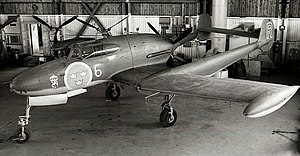Saab 21
| Saab 21 | |
|---|---|

|
|
| Type: | Fighter plane |
| Design country: | |
| Manufacturer: | |
| First flight: |
July 30, 1943 |
| Commissioning: |
1945 |
| Number of pieces: |
298 |
The Saab 21 was a single-seat, single-engine Swedish fighter aircraft in low-wing design .
construction and development
The development work on the aircraft, equipped with a pusher propeller , retractable nose wheel landing gear and a double tail unit carrier, began in 1941 under Frid Wänström . Construction manager was A. J. Andersson. The Swedish Air Force initially ordered three prototypes. Claes Smith took off on its maiden flight on July 30, 1943 .
The machine was an efficient weapon carrier, as a 20 mm Hispano bow cannon and two 13.2 mm Bofors machine guns could be installed through the pusher propeller in the aircraft nose. A further 13.2 mm Bofors machine gun sat in each wing. There was space for bombs and missiles under the fuselage. The pilot's forward visibility was also excellent.
The first machines were still equipped with a German Daimler-Benz DB 605 B. In order not to endanger the pilot in an emergency with the propeller in the tail, Saab developed its own type of ejection seat . The Saab Mk.I ejection seat was first tested on February 27, 1944 with a 100 kilogram dummy at 405 km / h at an altitude of 1200 meters. On July 29, 1946, the ejection seat was used for the first time after a collision between a J 21A and an FFVS J22 . Despite the modern design, a pressurized cabin was not provided.
At the end of 1945 the J 21A-1 was built , which received a DB-605B engine built under license in Sweden. 54 copies of it were built. 124 pieces of the next version J 21A-2 were procured and 120 pieces of the last version A 21A-3 . The A-3 had the ability to take additional external loads and so to be used as a ground attack aircraft .
A total of 298 machines of all types (with prototypes) were produced by 1949. The Swedish Air Force used the machines until 1951. A higher production number was actually planned; However, the J 26 Mustang , which was available after 1945, and the new jet engines caused interest in the Saab 21 to wane.
In 1947 a turbojet engine of the type De Havilland Goblin -3 was used in four machines ; this led to the Saab 21R jet fighter , which remained in service as a ground attack aircraft until 1957.
Technical specifications
| Parameter | Data Saab A 21-3 |
|---|---|
| crew | a pilot |
| length | 10.45 m |
| span | 11.60 m |
| height | 3.97 m |
| Wing area | 22.20 m² |
| Wing extension | 6.1 |
| Empty mass | 3,250 kg |
| Takeoff mass | 4,413 kg |
| drive | a Daimler-Benz DB 605 B with 1,475 PS (1,085 kW) |
| Top speed | 640 km / h |
| Service ceiling | 11,000 m |
| Range | 750 km |
| Armament | 1 × 20 mm Hispano bow cannon, 4 × 13.2 mm Browning machine guns, bombs, missiles |
Picture gallery
Web links
- Saab J 21 / A 21 / A 21R (English)
- Ejection seat of the Saab 21 (English)




